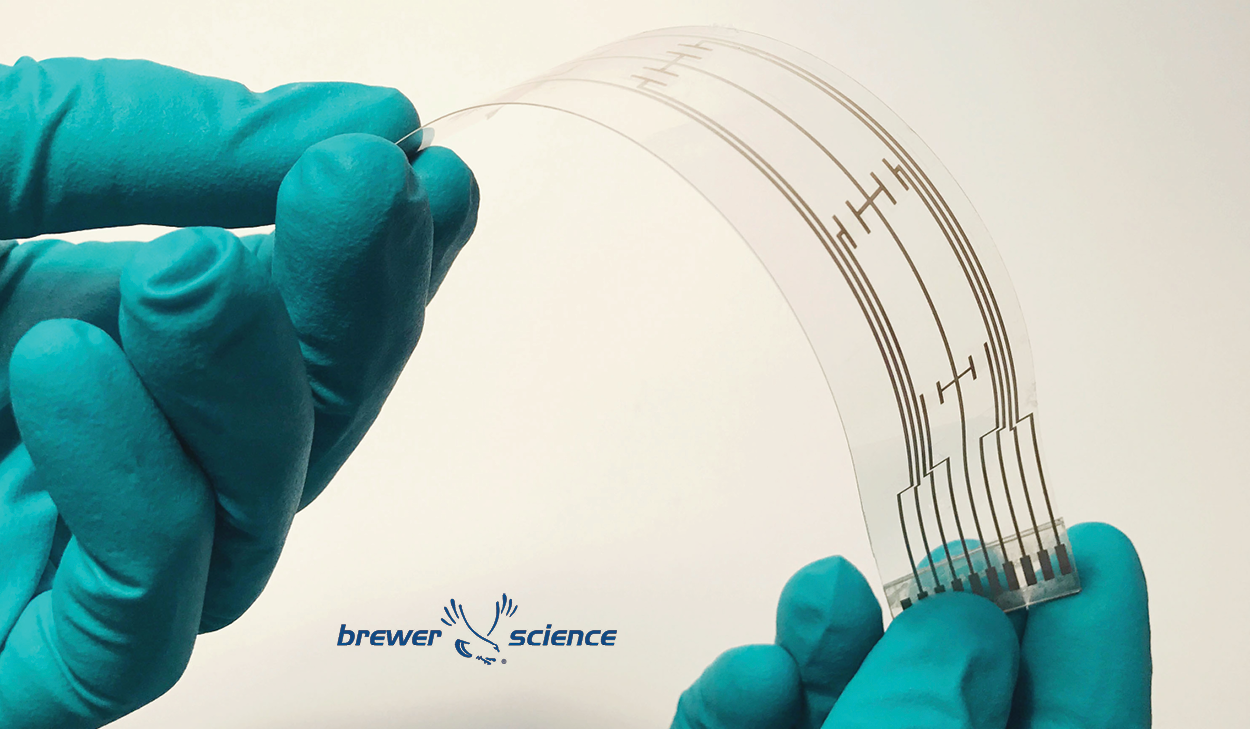In the not-too-distant future, we may routinely see smart food labels wrapped around meat packaging to digitally count down its expiration date. Perhaps a tiny device stuck to your car windshield will provide you a continual weather forecast, or a patch worn around your wrist will monitor your blood sugar levels in real time.
All those electronics should be achievable soon through the advancement of printed electronics, a methodology many at Brewer Science view as the wave of the future. Just as Dr. Terry Brewer revolutionized the semiconductor industry 35 years ago by inventing the anti-reflective coatings that make nanoscale circuitry possible, Brewer Science is now continuing that tradition through its innovative use of printed electronics.
Why the buzz at Brewer Science? The science involving the stacking of micro-structured layers is a versatile, easy-to-integrate, energy-efficient and relatively low-cost way of transferring electrical devices to various substrates, including flexible, curved, thin and/or lightweight surfaces such as labels, antennas, packaging, upholstery, books, skin patches, batteries and clothing.
All that jives well with Brewer Science’s history as an entrepreneurial company that’s had great success formulating its own innovative components.
The technology allows Brewer Science scientists and engineers to solve electronics problems, including security, reliability and durability issues that can’t be solved with more traditional methods, according to Executive Director Dr. Dan Brewer.
“We look at (printed electronics) as an opportunity to use our materials expertise and our materials competency ... and build brand new devices, sort of from the bottom up,” he notes. “We’re going to be taking unique materials we invent, using those to create brand new device architectures, then putting those devices into subsystems, components, maybe even complete systems that Brewer Science will be selling into the marketplace. This is a unique approach to a certain extent for printed electronics, but we believe it’s a very strong approach for us as a company.”
Brewer Science first began focusing on and investing in printed electronic systems about 10 years ago, launching operations at its advanced materials and inks division before moving into the design and development of its own printed sensors. The company initially installed discrete sensors into its own line of devices, and now creates custom systems for its customers that include specialized material and ink design, sensor design, secure firmware for customers’ data-gathering needs and an easy-to-manage software interface.
These days, Brewer Science devices and electronics can be integrated into virtually any point of a client’s supply chain, addressing a wide variety of needs and solving a wide array of problems. Most systems the company has designed to date focus on the monitoring of equipment, emissions and the environment.
Printed electronics are rapidly becoming vital to multiple industries including healthcare, aerospace, media, transit, solar and finance. A recent IDTechEx report predicts the annual global market for printed, organic and flexible electronics will reach more than $73 billion by 2025.
“Not all separate types of printed electronics will share equally in that big market,” notes analyst Harry Zervos in the report. “(It’s) an umbrella term, and some markets will reach maturity sooner than others. But already, OLEDs, conductive inks in PV applications and printed glucose sensors are billion-dollar markets that are set to grow.”
MIT professor A. John Hart shares that optimism. “There is a huge need for printing of electronic devices that are extremely inexpensive but provide simple computations and interactive functions,” he says in a recent MIT article.
Brewer Science predicts that printed electronics will eventually be applied to the formation of smart cities that use electronic data collection for asset and service management, efficient use of resources and optimal quality of life.
“We’re asking ourselves, ‘Where’s the value printed electronics can bring to that? Who’s going to be paying for it? Why are they going to be paying for it?' And then, 'Where’s the need for those unique characteristics that can be created through different materials and device architecture?' We’re excited — we believe printed electronics is a great place to be. We believe Brewer Science has a great opportunity to really add value to the industry, and to help the whole industry grow and move forward into the next decade.”
Hear from Executive Director of Intangible Assets and New Business Development, Dan Brewer, to learn how Brewer Science is affecting the market.




Subscribe to Our Blog